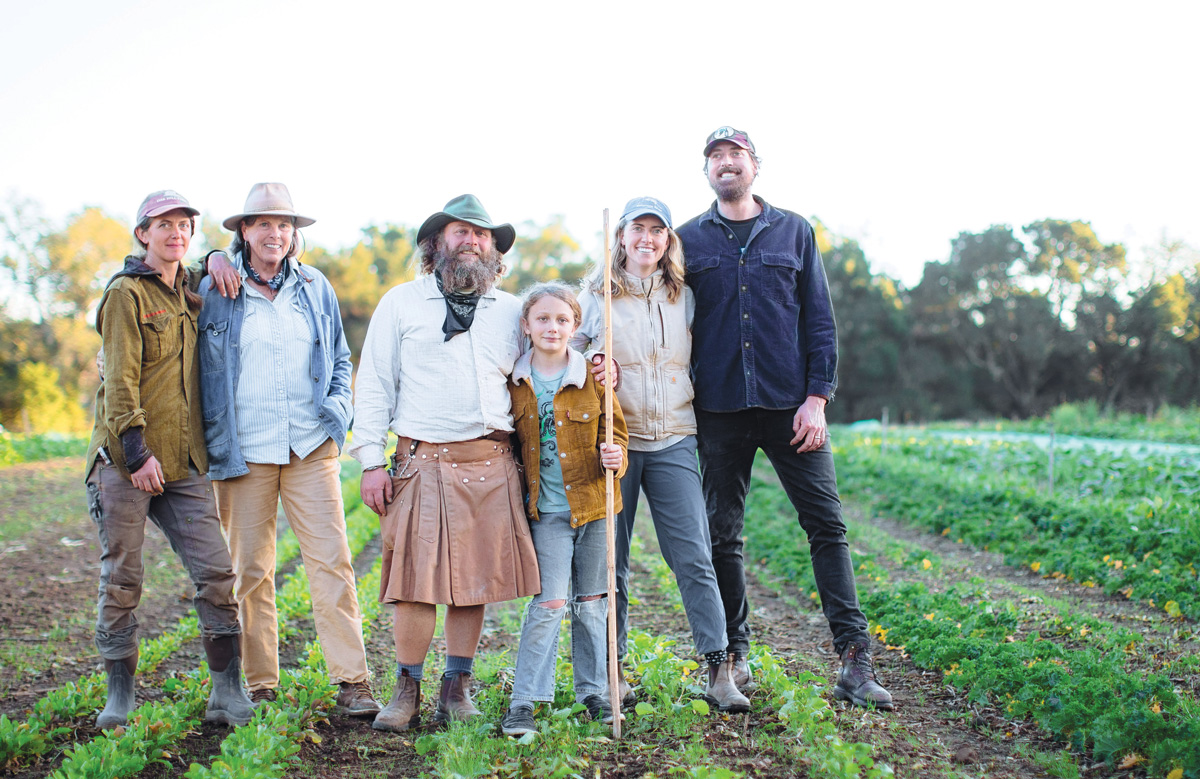Heirloom & Heritage
A New Generation Takes Root at Oak Hill Farm
Every Saturday but for a few in the absolute dead of winter, a steady stream of cars turn off Highway 12 toward a picturesque red barn. This barn, as barns go, is the Platonic ideal: in possession of all the qualities that distinguish barns from not-barns. It is red, as mentioned, and capaciously scaled, with a gently sloping roof and massive doors that rattle mildly against their hardware when pulled. Inside, it is cold when the weather outside is also chilly, and it’s warm when summer sunshine makes the air molecules expand and move fast.
It’s a barn, not a living room, see—though for Melissa Bucklin and Jimi Good it is also something like home. They are the farmers who supply the red barn with all manner of grown produce and sell it to the people who motor up the long driveway each week.
For more than 50 years Oak Hill Farm has been growing food and flowers in Sonoma Val-ley, charting a uniquely prescient course in the region’s agricultural story. The farm was organic decades before the practice was vogue, and water conscious before anyone even thought to think conservation. The farm’s co-founder, Anne Teller, grandmother to Melissa, refused chemical fertilizers and pesticides on gut instinct and principle decades before science stood up, cleared its throat and made the case for organics at long last. She and her husband, Otto, preferred solar power and human labor to the ease of machines, and instinctively understood crop rotation and crop diversity somehow.
But back then, Oak Hill Farm was more hobby than business. Anne and Otto grew flowers because they liked to, and refused mechanization because they could. They had a crew of regular workers from Mexico who would come up for the growing season, seasoned farmers willing to work 16-hour days.
“There were no laws about overtime,” Melissa explains. “They would work for eight months and work as many hours as they could.”
Today, labor laws limit the workday to eight hours and the workweek to 40. Anything beyond that entitles employees to time-and-a-half wages, making the already-elevated expense of organic farming cost-prohibitive.
“It’s not sustainable,” Melissa says of her grandmother’s model. Then as now, people migrating from Mexico come for different reasons. “They’re escaping violence from more urban areas,” Jimi says. “They’re coming for factory work, restaurant work and construction now,” Melissa adds.
And so, Oak Hill Farm’s next generation has embraced a new pragmatism. To stay viable, they’ve had to pivot. They’ve limited flower production because flowers are hard to transport, and because growing them takes a specific skill set.
“It’s easy to walk up to a tomato plant and say: ‘This one is ripe; I can pick that,’” Jimi says. “But when you walk into a bed of Agrostemma it’s not as easy to recognize a flower that will be perfect three days from now, and then have to find 20 more of them exactly like that, then do that a bunch more times. Tomatoes are, like, ‘red, put it in the basket; green, walk on by.’”
Melissa and Jimi hedge their bets at Oak Hill by growing a greater variety of foods, too, cultivating as many as 200 types of fruits and vegetables across the farm’s active plots. The entirety of Oak Hill spans almost 700 acres, but most of that is protected from development—agricultural or otherwise—in perpetuity by the Sonoma Land Trust.
“We can use any piece of land below a 400-foot elevation for any agricultural purpose,” Jimi explains of the trust’s parameters. “That would include maybe 300 acres, but we don’t utilize anywhere near that. There’s probably 30 or 40 acres available of actual good farmland. Our current crop plan consists of about 15.”
Since taking over farming operations at Oak Hill a few months before the pandemic shut the world down, Melissa and Jimi have worked to mechanize a lot of the more backbreaking tasks, to protect their staff’s well-being and the bottom line alike.
“Now, what used to take hours and require a lot of crawling around in heavy clay soil can be done in five minutes,” Jimi says of the $15,000 transplanter they purchased to increase productivity. It’s a shift from the vision Anne and Otto began with, but the family is playing with a different deck 50 years on. Arden BucklinSporer, one of Anne Teller’s four adult children who is—along with a sister—co-owner of the farm, enthusiastically supports this embrace of modern standards. Of trying to produce food across 15 acres without benefit of machines, Bucklin-Sporer says bluntly, “It’s ridiculous, absurd.”
The Red Barn is the key to the farm’s new business model: It is the retail space where most of the produce is sold. Jimi trucks food to local farmers’ markets every week, and sells produce to local grocers and restaurants, too, but the bulk of Oak Hill’s business transacts at the barn.
“The pandemic really shifted people’s value systems around food,” Melissa says. “People began realizing what is required to make cheap food. In order for people to find the value in $3.50-a-pound carrots versus $1-a-pound carrots, they have to understand how we’re different from industrial agriculture.”
Aside from the fundamental differences inherent to organically grown food, the main divergence of factory farms from family farms is the human component. As a rule, farming operations done on an industrial scale use temporary labor. One farmer might plant 300 acres of broccoli, for instance, while his neighbor plants 300 acres of a crop harvested at a slightly different time. They’ll share the same small cohort of day laborers on rotation, itinerant workers who never have real consistency, job security or semblance of life-work balance. Things are different at Oak Hill Farm. “We pay a living wage and treat our staff like human beings,” Melissa says proudly.
But it’s not all rainbows and flowers in the organic farming world, either. Every season is a gamble, each crop vulnerable to some new blight or scourge. Jimi is sanguine about the risks. “We’re out here, gambling all the time,” he says, smiling. “But we’re gamblers who know how to count cards.”
Neither Melissa, 39, nor Jimi, 41, expects or aspires to great wealth. They are both simply farmers, through and through. Their days pass in steady effort, following the sun, and their bank ledgers tend to run on thin margins. “Being broke is just a reality in agriculture,” Melissa admits.
But they’re raising their two sons on a wild slice of land, where lithic artifacts rise from the soil still, telling ancient stories. The struggle, the uncertainty, the effort of this life? Worth it. Oak Hill Farm just abides.
“In an 80-hour week, there’s maybe five hours I have to spend doing something I don’t like,” Jimi says. “I can’t imagine doing anything else.”
Find Oak Hill Farm produce at Sonoma Valley Farmers’ Market
284 First St. West, Sonoma, Fridays year-round (rain or shine), 9 am –12:30pm
Red Barn Store, 15101 Sonoma Highway, Glen Ellen
Open April–December: Saturdays 9am–3pm, Wednesdays 3–7pm
THE PRAGMATIST
“There are a lot of farms in the Valley where the bottom line doesn’t really matter,” Arden Bucklin-Sporer says. “That’s not us.” How does a small family farm build a strong bottom line? “Data.” But data collection doesn’t sit naturally at the top of any real farmer’s to-do list. “A farmer really doesn’t want to collect data,” she says. “They want to be out in the fields. But how can you know how you’re really doing if you don’t collect data? You can’t.”
Arden Bucklin-Sporer is the third leg of Oak Hill Farm’s operational stool, balancing the Herculean efforts of Melissa and Jimi so that the whole enterprise stands stable and strong: She keeps the spreadsheets, tracks the data, takes the classes in family farm management. “I used to be in the movie business, so I sort of think of myself as the executive producer,” she says.
When Arden and her sister, Kate Bucklin, inherited Oak Hill from their mother five years ago, the bequest didn’t include a bottomless bucket of cash. Seven hundred acres don’t manage themselves. “We have to be a farm that works. We have to be a real money-making farm,” she says.
EQIP grants through the USDA help with maintenance of the forests that dot the farm’s sprawling acreage. But mostly it’s down to her to figure a calculus that works.
Storage crops are the ticket, according to her data. Easier to produce and amenable to elapsed time. “Potatoes. Winter squashes. Turnips. Carrots,” she says. “We grow magnificent carrots. Just spectacular.”
And lettuces, too, despite their need to be consumed soon after harvest. Lettuces grow quickly and over a long season. These are the mainstays, the stalwart performers—or they were last year, at least.
But it’s the Mara Des Bois strawberries that draw people to Oak Hill. Sweet, fragrant and impossible to stop eating, the tiny berries are the farm’s A-list star. “We sell them for ungodly amounts of money and we still don’t make a profit,” she says. “But it brings people in. You have to think about those loss leaders a little bit, too.”
The problem of profitability is never settled on a farm. There’s always a next hurdle on the near horizon. “My goal in this coming year is to really understand which of our plants is going to drive our productivity and financial gains,” she says. “I’d like to see a little bit of a stronger bottom line.”












